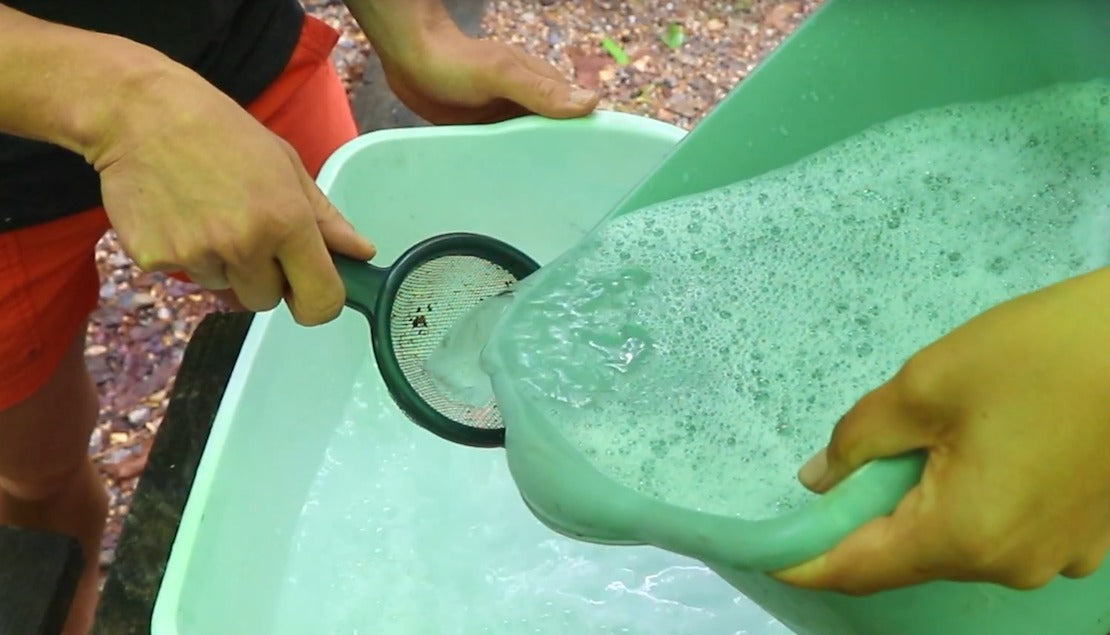Disposing of Wastewater
Regulations vary between countries and states, and are even made on a campsite by campsite basis; therefore it's important to check what the guidelines are at the campsite or park you're visiting.
What is Greywater
“Greywater,” or non-toxic wastewater, is produced when washing dishes, brushing teeth or using a portable camping shower. If you’re planning a trip that includes any of these activities, it is important to know the local guidelines for greywater disposal; improper discarding can cause pollution and harm wildlife.
Biodegradable Soaps
Carefully consider the soaps and other products you use while showering and washing dishes at a campsite. These substances can impact nearby water sources, which are critical for wildlife. Even biodegradable soaps, while better for the environment, will only decompose in soil, so dumping them in a fresh water source is not sufficient. Chemicals of any kind will change the composition of the water and can make it unsuitable for drinking.
Try to select fragrance-free products made from natural ingredients and use a 1:3 water dilution ratio – you need less soap than you think! Bring sponges and scrubbers made from organic materials, so you can be sure you’re not contributing microplastics or other pollutants to the ecosystem.
We've written another article about eco-friendly products for camping here
Disposing of wastewater
When you’re finished washing dishes or using your camping shower, wastewater should be strained into a container using a metal strainer. By catching food and dirt particles, you can dispose of them along with other solid trash and avoid attracting animals. Then, according to local regulations, the water can be disposed of in one of several ways:
- Dumping in designated utility sinks
- Pouring down labelled greywater or wastewater drains
- Discarding in vegetated or barren areas, away from your campsite and water sources

Because there are not always widespread guidelines for wastewater disposal, get in the habit of checking the rules at each campsite or park you visit. When in doubt, follow the guidance for straining and disposing of greywater in the wild.
Country-Specific Rules
United States
Land across America is managed by many different entities, which can make rules and regulations confusing to keep track of. With regards to greywater, guidelines from the U.S. Forest Service (FS), Environmental Protection Agency (EPA), Bureau of Land Management (BLM), and National Parks Service (NPS) all state that, for the most part, disposal should be done 200 feet from water sources, based on the Leave No Trace principles. The Boondocker’s Bible is a great camper’s resource to research all these restrictions in detail.
Additionally, NPS reminds us that many campsites have designated greywater dumping areas, and some national forests and parks prevent the dumping of wastewater altogether, so be sure to check with local authorities and resources when visiting.
United Kingdom
UK laws state that you may not dispose of greywater anywhere other than a designated area, to include on roads or laybys. Some campsites may have greywater collection bins since it is often reused for hedgerow watering, but always be sure to dispose of greywater and sewage separately, as defined by campsite owners.
The Camping and Caravanning Club and the Campervan and Motorhome Professional Association have published guidance on disposing of wastewater in the UK, both of which are helpful resources for campers.
Australia
As in the US, rules for greywater disposal vary across Australia. Out west, it may be favorable to reuse it to water vegetation, but on the east coast, dumping it could result in fines. Always be sure to check regulations from governing agencies (via the office of the Director of National Parks, Parks Australia, or the National Parks and Wildlife Service website) as well as local guidelines on site; national parks tend to have their own designated disposal areas.
Especially in Australia, it is also important to factor in temperature to your disposal plan; greywater can accumulate substantial bacteria if left in warm temperatures, which means it could become even more toxic than sewage. For this reason, in Western Australia, untreated greywater cannot be stored for longer than 24 hours.

In alignment with their commitment to Leave No Trace, the Campervan and Motorhome Club of Australia has detailed instructions on constructing and attaching a greywater container if you are required or inclined to “pack it out.” For more specifics on RV and campervan greywater disposal, visit RV Daily.
A good rule of thumb is to keep a lookout for signs that indicate that a campsite requires visitors to be “Fully Self-Contained.” This would require you to retain your greywater to be disposed in a specific drain or to be packed out of the park altogether. Otherwise, if disposing of greywater is allowed at the campsite, be sure to get a wide berth from natural streams and lakes; authoritative guidelines range from 10 to 30 meters away from water sources. For more tips on retention methods, visit the Full Range Camping website.
New Zealand
In both Australia and New Zealand, you can certify your vehicle as “self-contained” if it meets a series of requirements for waste removal. Read more about the certification guidelines on the NZ Government website.
If you’re driving a self-contained vehicle while camping, familiarize yourself with the AA, Camper Mate, and Camp NZ apps; search for “Dump stations” on the map to get directions to the nearest safe dumping location. Plus, keep an eye out for dumping station signs while you’re on the road (see pic).
Read more about freedom camping at freedomcamping.org.
